1. Introduction
Sergei Rachmaninoff (1873 - 1943) was a highly skilled composer and pianist. Although the era in which he lived was marked by the rise of modernism in Western music, Rachmaninoff remained a devoted Romantic composer and is often regarded as the last great proponent of Russian Romanticism in the 20th century [1]. This paper focuses on the fifth piece of Etudes-Tableaux, Op. 33, composed in 1911, during the middle of Rachmaninoff's career.
Previous studies have focused on various aspects of this piece. For example, Wang Zilin explored the performance techniques of this piece [2], while Pang Yuxin analyzed its compositional characteristics [3]. Liu Yu compared performances by renowned pianists such as Sviatoslav Richter, Vladimir Ashkenazy, and Vladimir Ovchynnikov [4]. However, none of these studies compare the performances of Lugansky and Kobrin. This paper aims to fill that gap by comparing their interpretations and offering suggestions for mastering the technical challenges of the piece.
2. Background of Composition
Rachmaninoff's works are deeply influenced by Tchaikovsky and are characterized by intense emotional expression, complex textures, and rich harmonies. His music often reflects the vastness of Russian nature and echoes the melodies of Russian folk songs. In addition, the traditional music of the Russian Orthodox Church left a profound impact on Rachmaninoff, which is evident not only in his sacred works but also in his other compositions, where elements of religious music frequently appear.
Rachmaninoff's style combines the refined, delicate expression of Romantic music with symbolic undertones, giving his compositions a passionate, Romantic character [1]. One significant source of inspiration for Rachmaninoff was the sound of bells. He once reflected: "Throughout my life, the sound of bells has often evoked different emotions—sometimes joyful, sometimes tragic, depending on my state of mind. I recall that during my childhood in Novgorod, I would listen to the four-toned bells of St. Sophia's Church with my grandmother. The ringing of the bells felt artistic to me, and I wanted to capture that emotional quality in my music. The sound of the Moscow bells has accompanied me for most of my life, and it has shaped my artistic expression." [5]
In this environment, Rachmaninoff experienced many personal challenges. His parents' divorce, the death of family members, and financial hardship cast a melancholic shadow over his life. The church bells he heard as a child, particularly during festivals with his grandmother, became a lasting emotional connection for him.
In Etudes-Tableaux, Rachmaninoff weaves together 19th-century Romanticism with Russian national culture, allowing listeners to feel the powerful national spirit of Russia. The "bells" he often spoke of resonate throughout this piece, adding a distinctive and refreshing element to the music. Rachmaninoff infused the piece with his personal emotions, and this connection makes the work stand out in its emotional depth.
3. Comparison of Two Interpretations
The author compares the performances of pianists Nikolai Lugansky and Alexander Kobrin, analyzing their playing techniques and styles. The same piece of music can evoke different feelings and effects depending on the techniques used. This comparative analysis helps readers better understand the distinct styles and techniques present in this work.
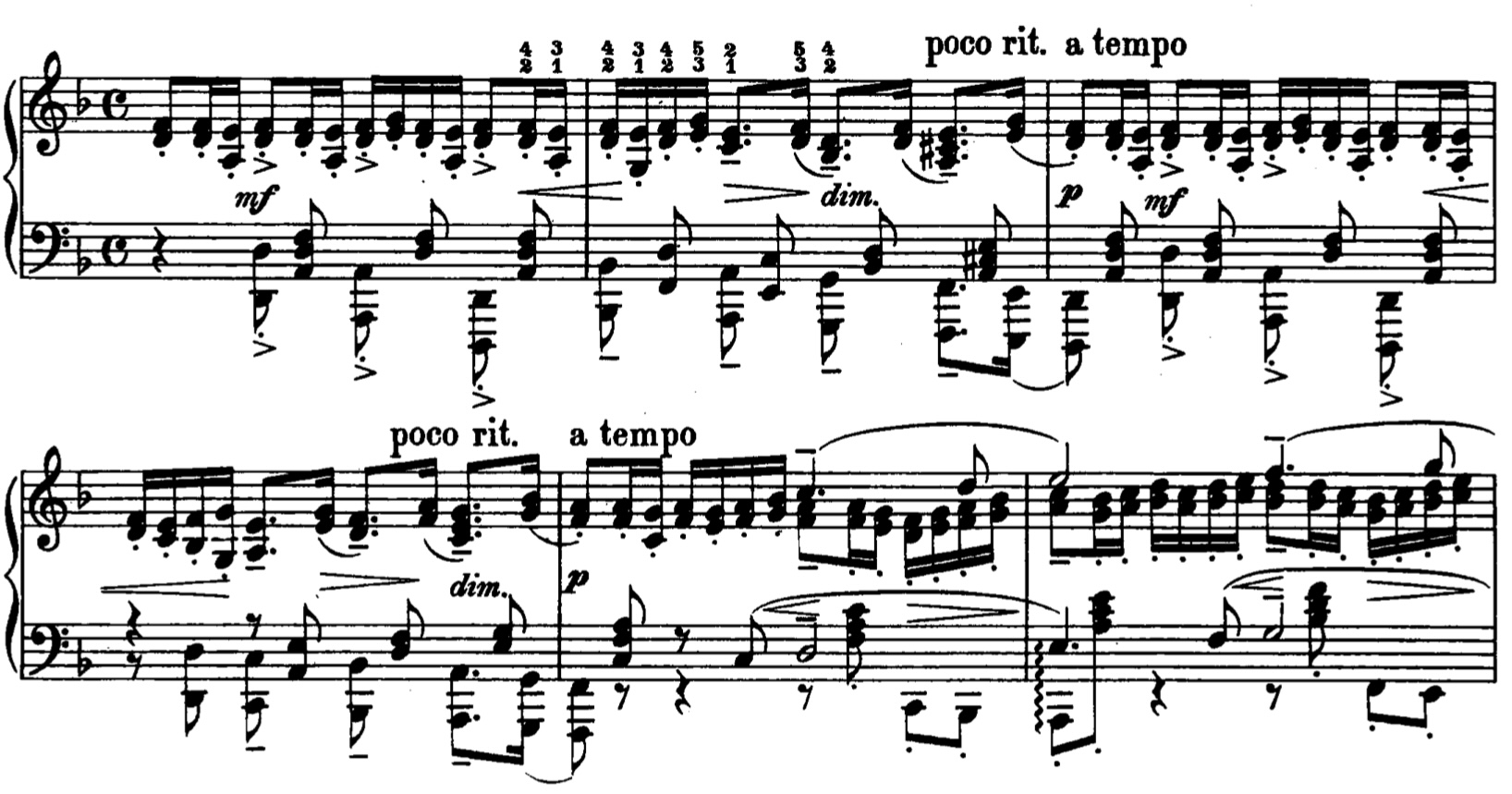
Figure 1: mm.6-11 [6]
The author has extracted a section of the piece for comparative analysis. As shown in Figure 1, Lugansky's interpretation aligns more closely with the tempo of the original score, whereas Kobrin adds his unique interpretation. For instance, after the quarter note of the motif in the third measure, Kobrin makes a slight pause to help the listener immerse in the mood. He then employs a crescendo to transition into the theme more seamlessly. This approach allows for greater musical freedom, with variations in speed. Kobrin's personalized interpretation is refreshing. In contrast, Lugansky's performance is more restrained, exhibiting little musical freedom while demonstrating great fidelity to the original score. However, beneath this seemingly "ordinary" performance, one can sense the player's unsettled inner emotions, which adds a deeply moving layer to the music.

Figure 2: mm.12-14 [6]
In Figure 2, the differences in technique between the two pianists become evident. Lugansky emphasizes the right-hand melody in this phrase, while Kobrin highlights the left-hand melody. The contrasting interpretations by the two pianists enhance the piece's mystique and engage the listener's interest.

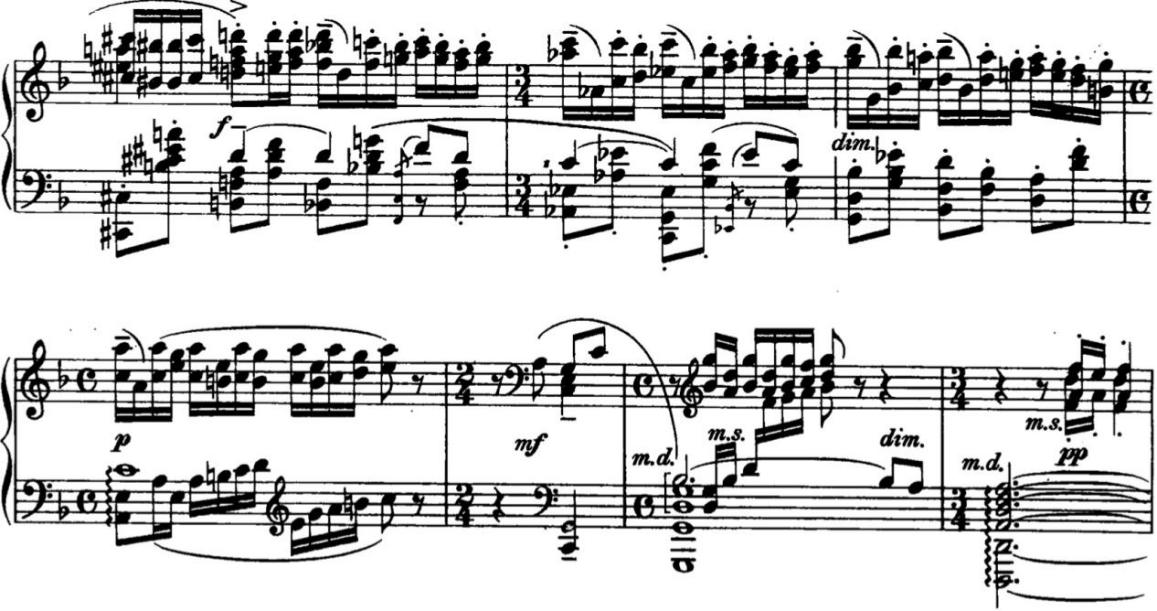
Figure 3: mm.31-39 [6]
Beginning with the passionate "bells" melody in Figure 3, Lugansky once again emphasizes the right-hand melody. However, unlike in the previous example, he incorporates his own interpretation in this section by varying the tempo. It is as if the bells in different registers are struck in succession, highlighting the crisp and lively right-hand "bells" melody. Kobrin, while also emphasizing the right-hand melody in the first two measures, chooses to add weight to the left hand in the subsequent measures. The interplay between the left and right voices creates a "ringing" effect, with the low "bells" and the cheerful "bells" blending together harmoniously, resulting in a refreshing contrast.
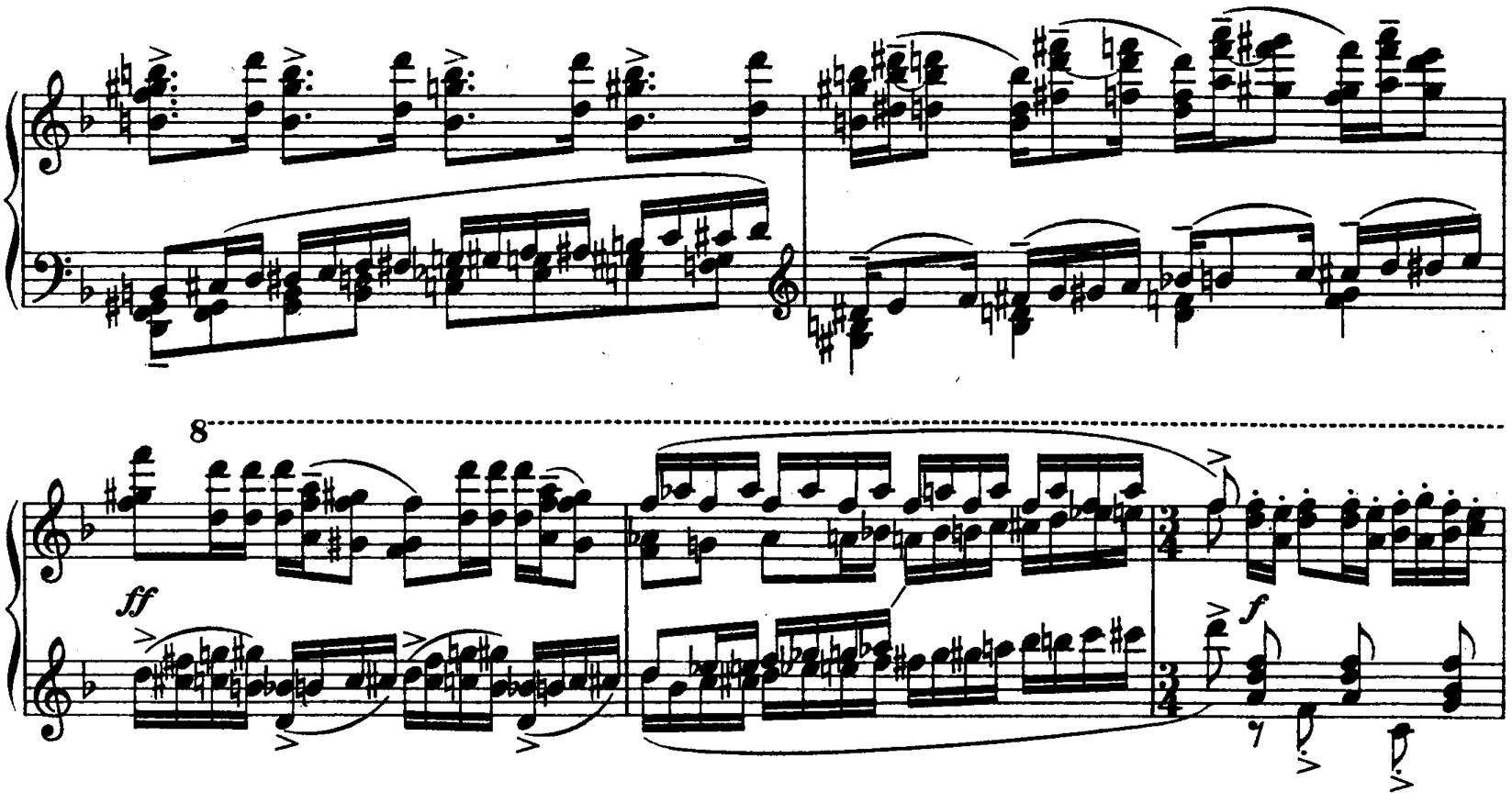
Figure 4: mm. 49-53 [6]
In this section, which captures the final "madness" of the storm as shown in Figure 4, the two pianists provide distinct interpretations. Lugansky adopts a restrained approach in this section, avoiding a pronounced crescendo. He emphasizes the "bell" melody in the right hand, making it sound as though it were a real bell. In contrast, Kobrin employs a pronounced crescendo and even accelerates the tempo, adding his unique interpretation. The intensity of the melody creates an image of a terrible storm, evoking a sense of oppression. Kobrin deliberately slows down the right-hand "bells" melody, creating a strong and vivid imagery.
4. Analysis of playing techniques


Figure 5: mm.1-5 and 60-63 [6]
As shown in Figure 5, the musical theme of "bells" is used both at the beginning and at the end of the piece, and the "bells" are both the beginning and the end of the story of the storm. To play this piece, you need to lighten the intensity, play with your fingertips, and gently stroke the keys to produce a soft tone. But be careful that stroking the keys doesn't mean breathlessness; deep touching of the keys works just as well. The melody in the right hand stands out, to be penetrating, as if it were a bell ringing in the distance, if not there, but impossible to ignore. In both phrases, the line is also very important, and a correctly done break is the finishing touch to the section.
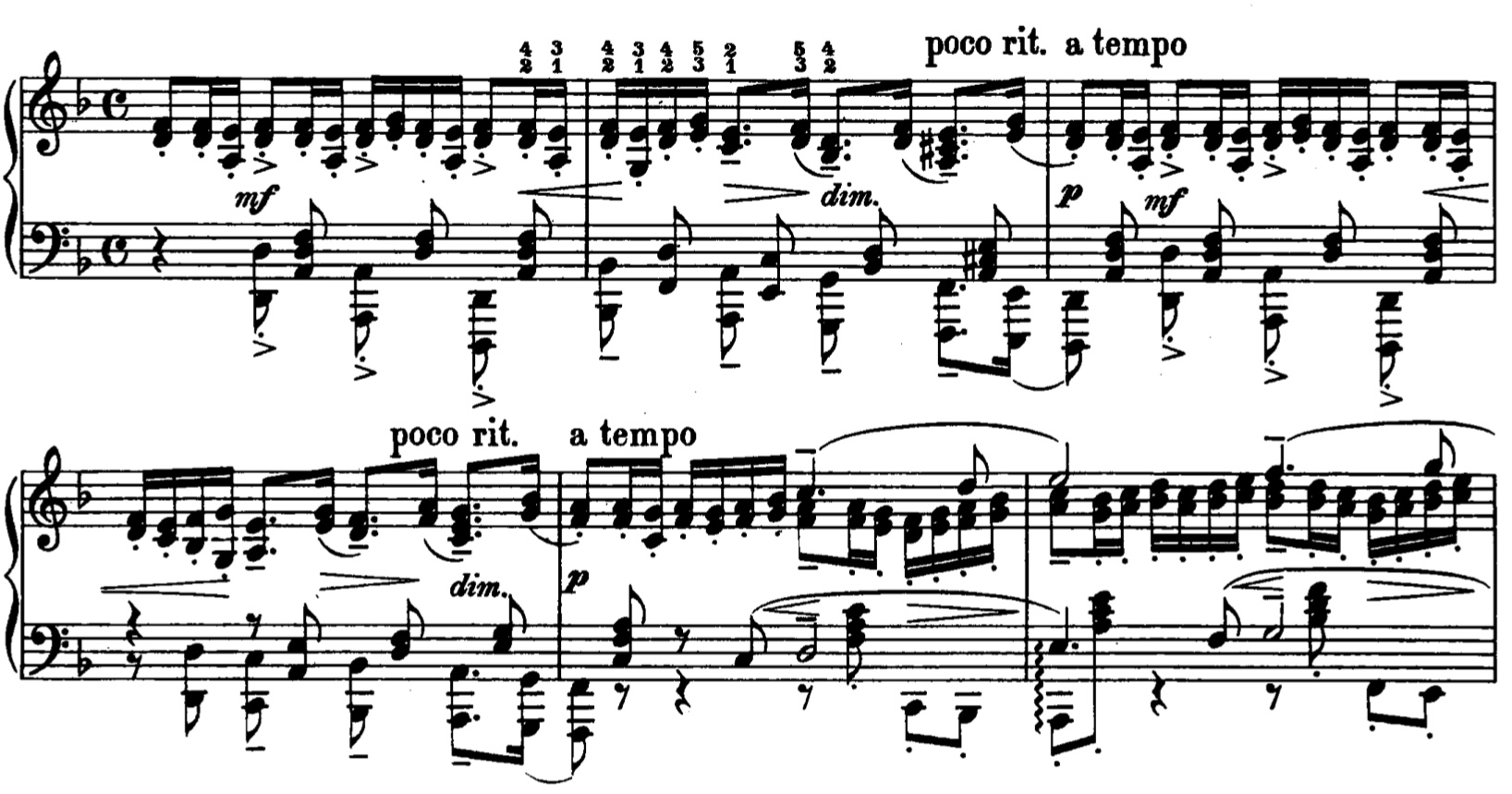
Figure 6: mm.6-11 [6]
Figure 6 illustrates that this piece features a significant amount of double or chordal legato, requiring short but powerful key strokes. It is undoubtedly challenging to strike the keys quickly while producing a melodic sound. Therefore, the performer must focus intently on practicing this piece. It is vital to emphasize the melody while ensuring that the chords are played cleanly. Practically, one can achieve this by using a quick wrist push to execute a doublet, while simultaneously relaxing to prepare for the next doublet. This technique helps conserve energy and relax the wrist. Given the complexity of the piece, it is essential to concentrate on the main melody while maintaining clarity in the keys.
The contrasts of strength and weakness are equally significant in this étude. The piece depicts the story of a snowstorm, and, in the author's opinion, every dynamic marking reflects the storm's changes. Liu Yu discusses this in detail: "In terms of the changes in intensity, his greatest characteristic is that the juxtaposition of strength and weakness is prominent. For example, the first measure is p, the poco crescendo appears in the fourth measure, the mf in the fifth measure, and then it grows stronger and weakens, returning to p in the seventh measure, before starting to grow stronger again. This series of changes in force illustrates the scene of an approaching storm, with intensity constantly rising and falling, akin to a raging gust of wind and snow, creating a sense of tension and immersion" [4].

Figure 7: mm.31-32 [6]
As shown in Figure 7, a chord containing an octave occurs at the climax of the piece. This section transitions from weak to strong, and while attention must be paid to strong and rapid key strokes, it is equally important to focus on the contrasts in dynamics. The chords in both the left and right hands should be distinctly set apart. This requires not only a precise downstroke but also careful consideration of the dynamics involved. Forming a sharp crescendo necessitates practice and refinement. At the same time, it is crucial to ensure that the chords are neatly played. Practicing the octave touch separately can help before integrating it into the overall performance. Similarly, knowing how to conserve energy during long and rapid key strokes is vital; performers should utilize their wrist strength correctly to avoid straining the wrist.
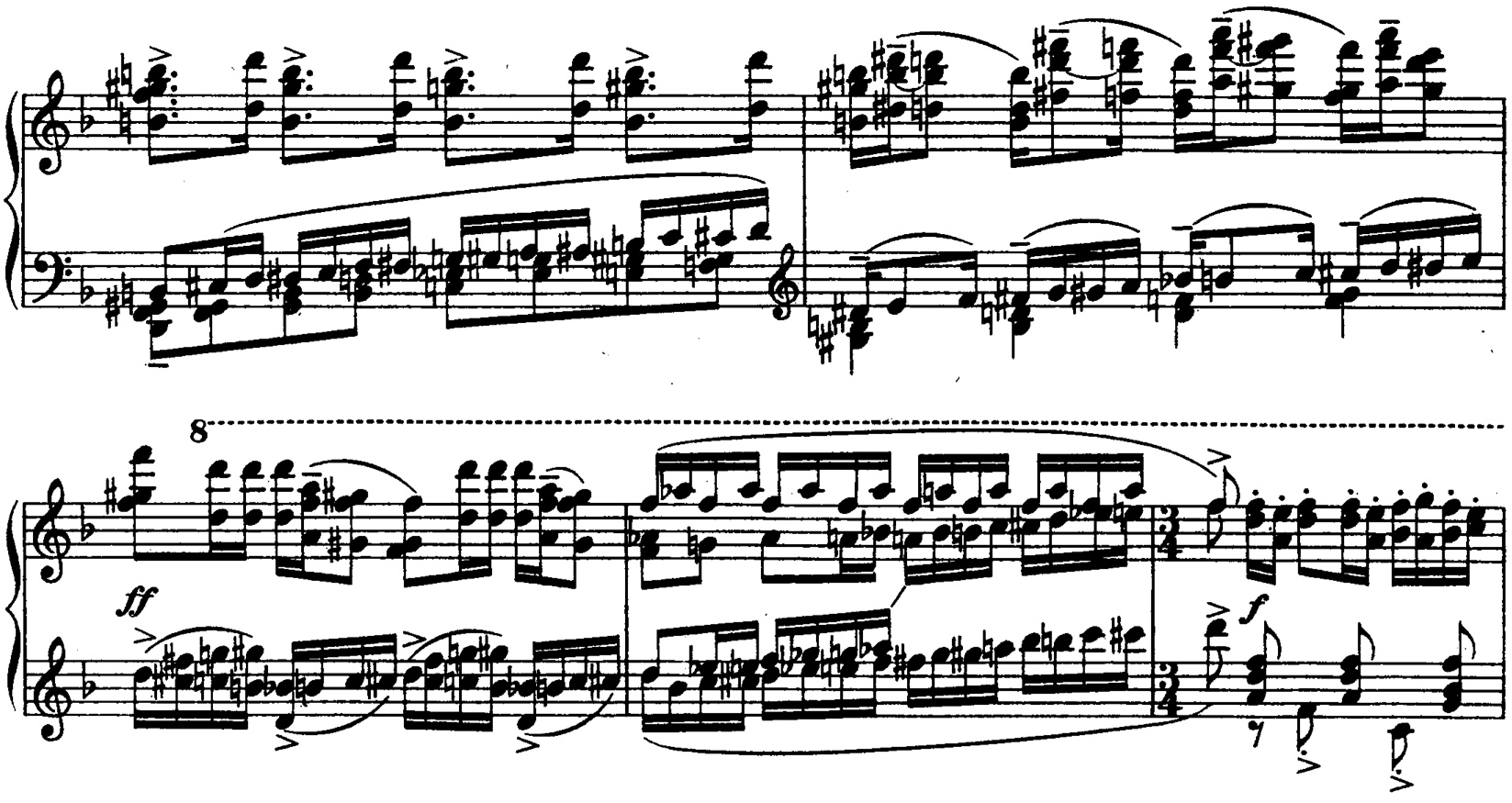
Figure 8: bars 49-53 [6]
As shown in Figure 8, this fragment contains a lot of skipping and legato. While emphasizing the melodic notes, the player needs to master different ways of touching the keys in order to show the continuous, broken, false and solid variations of the tone. Skipping requires the fingers to leave the keys quickly, but the movement should be small and focused, avoiding too much involvement of the arm and wrist. Legato requires attention to the breathing and coherence of the phrases, avoiding rigid connections between notes. In the process of practicing, you can first play single notes fluently and then add one note after another until you get the ideal state in your mind. It is important to note that consecutive chord progressions can be difficult, so avoid being impatient. Take your time and play each chord clearly, while practicing fast key strokes. A clean and tidy tone is the foundation of this piece.
Overall, this piece requires a high degree of control over tempo and rhythm. Performers need to accurately grasp the rhythmic characteristics and tempo changes of the piece. In the process of practicing, a metronome can be used as an aid to ensure the stability and accuracy of the rhythm.
5. Conclusion
Rachmaninoff successfully combined piano technique with musical expression to create the genre of Etudes-Tableaux, rooted in tradition yet infused with innovative elements. By comparing the interpretations of this work by two performers, the author summarizes their distinct performance techniques. These techniques evoke different sensations for the listener, thereby highlighting the stylistic characteristics unique to each performer. This paper analyzes the piano playing techniques in the fourth piece of Rachmaninoff's Etudes-Tableaux, addressing the challenges in interpreting the work. The author hopes to provide valuable insights for players seeking to understand or perform this piece, focusing on technique and playing style to enhance their interpretations.
References
[1]. Ling Xianchu, Cui Bin. Western Music History and Masterpiece Appreciation Pu Xiu Tutorial [M]. Shanghai: Shanghai Conservatory of Music Press, 2021.
[2]. Wang Zilin. Research on the artistic characteristics and performance of Rachmaninoff's Sonic Picture Exercises OP.33[J]. Drama House,2024,(21):78-80.
[3]. Pang Yuxin. Compositional Characteristics and Performance Analysis of Rachmaninoff's Etudes Tableaux Op.33 No.5[J]. Artistic View,2023,(17):10-12.
[4]. Liu Yu. A Study on the Performance technique and performance version of Rachmaninoff's Etudes Tableaux Op.33 No.5 [D]. Tianjin Conservatory of Music,2016.
[5]. Liu Fang. On the "Bells" Episode in Rachmaninoff's Piano Works[D]. Xi'an Conservatory of Music,2008.
[6]. Rachmaninoff, Sergei. "Etudes Tableaux" op.33 no.5. Edited by Pavel Lamm, Konstantin Igumnov, Etyudy-Kartiny. Moscow: Muzgiz.1948.
Cite this article
Zhang,H. (2024). Interpretive Analysis of Rachmaninoff's Etudes Tableaux Op.33 No.5. Communications in Humanities Research,51,7-13.
Data availability
The datasets used and/or analyzed during the current study will be available from the authors upon reasonable request.
Disclaimer/Publisher's Note
The statements, opinions and data contained in all publications are solely those of the individual author(s) and contributor(s) and not of EWA Publishing and/or the editor(s). EWA Publishing and/or the editor(s) disclaim responsibility for any injury to people or property resulting from any ideas, methods, instructions or products referred to in the content.
About volume
Volume title: Proceedings of 3rd International Conference on Interdisciplinary Humanities and Communication Studies
© 2024 by the author(s). Licensee EWA Publishing, Oxford, UK. This article is an open access article distributed under the terms and
conditions of the Creative Commons Attribution (CC BY) license. Authors who
publish this series agree to the following terms:
1. Authors retain copyright and grant the series right of first publication with the work simultaneously licensed under a Creative Commons
Attribution License that allows others to share the work with an acknowledgment of the work's authorship and initial publication in this
series.
2. Authors are able to enter into separate, additional contractual arrangements for the non-exclusive distribution of the series's published
version of the work (e.g., post it to an institutional repository or publish it in a book), with an acknowledgment of its initial
publication in this series.
3. Authors are permitted and encouraged to post their work online (e.g., in institutional repositories or on their website) prior to and
during the submission process, as it can lead to productive exchanges, as well as earlier and greater citation of published work (See
Open access policy for details).
References
[1]. Ling Xianchu, Cui Bin. Western Music History and Masterpiece Appreciation Pu Xiu Tutorial [M]. Shanghai: Shanghai Conservatory of Music Press, 2021.
[2]. Wang Zilin. Research on the artistic characteristics and performance of Rachmaninoff's Sonic Picture Exercises OP.33[J]. Drama House,2024,(21):78-80.
[3]. Pang Yuxin. Compositional Characteristics and Performance Analysis of Rachmaninoff's Etudes Tableaux Op.33 No.5[J]. Artistic View,2023,(17):10-12.
[4]. Liu Yu. A Study on the Performance technique and performance version of Rachmaninoff's Etudes Tableaux Op.33 No.5 [D]. Tianjin Conservatory of Music,2016.
[5]. Liu Fang. On the "Bells" Episode in Rachmaninoff's Piano Works[D]. Xi'an Conservatory of Music,2008.
[6]. Rachmaninoff, Sergei. "Etudes Tableaux" op.33 no.5. Edited by Pavel Lamm, Konstantin Igumnov, Etyudy-Kartiny. Moscow: Muzgiz.1948.









